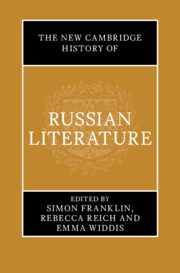Book contents
- The New Cambridge History of Russian Literature
- The New Cambridge History of Russian Literature
- Copyright page
- Contents
- Figures
- Contributors
- Acknowledgements
- On Transliteration, Names, and Dates
- Introduction
- History 1 Movements
- History 2 Mechanisms
- 2.1 The Monastery
- 2.2 The Court
- 2.3 The Salon and the Circle
- 2.4 The Thick Journal
- 2.5 The Publisher
- 2.6 Queerness
- 2.7 The Censor
- 2.8 The Voice
- 2.9 The Self-Publisher
- 2.10 The Market
- 2.11 The Internet
- 2.12 Empire
- Boxes 3 Places
- Boxes 4 Narrative Voices
- History 3 Forms
- History 4 Heroes
- Index
- References
2.7 - The Censor
from History 2 - Mechanisms
Published online by Cambridge University Press: 31 December 2024
- The New Cambridge History of Russian Literature
- The New Cambridge History of Russian Literature
- Copyright page
- Contents
- Figures
- Contributors
- Acknowledgements
- On Transliteration, Names, and Dates
- Introduction
- History 1 Movements
- History 2 Mechanisms
- 2.1 The Monastery
- 2.2 The Court
- 2.3 The Salon and the Circle
- 2.4 The Thick Journal
- 2.5 The Publisher
- 2.6 Queerness
- 2.7 The Censor
- 2.8 The Voice
- 2.9 The Self-Publisher
- 2.10 The Market
- 2.11 The Internet
- 2.12 Empire
- Boxes 3 Places
- Boxes 4 Narrative Voices
- History 3 Forms
- History 4 Heroes
- Index
- References
Summary
This chapter first outlines the history of imperial and Soviet censorship, before analysing the complex interactions of the multiple state and Party institutions, and individuals, that characterised censorship during Stalinism and post-Stalinism. The influence of Soviet censorship was profound, but somewhat unpredictable: not all elements of the censorship worked in harmony, and lines of authority were sometimes blurred. Censorship very often simply prohibited publication: as a result, many of the most talented authors of the twentieth century were appreciated only posthumously. Censorship could also, however, shape literary texts by generating complex textual strategies for concealing and revealing hidden meanings. Moreover, it could produce multiple versions of texts, either through continued rewriting to keep up with changing official requirements, or through the unpredictable reproductions that became common within the self-publishing network of samizdat. This meant that definitive versions of many important twentieth-century texts only appeared after 1991.
- Type
- Chapter
- Information
- The New Cambridge History of Russian Literature , pp. 333 - 352Publisher: Cambridge University PressPrint publication year: 2024

